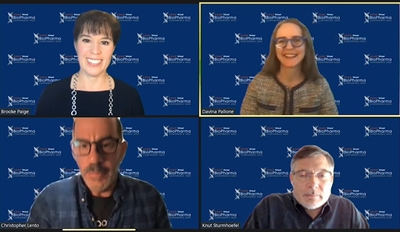Pharma and Tech’s Excellent Adventure: Making the Journey to Digital Health
Posted By Michael J. Burke, Monday, October 5, 2020
The road to digital health has been paved with good intentions: it’s about helping people take charge of their own health and wellness, after all. But it’s been a rocky road as well, and for pharma and tech companies taking the trip together, it’s been at times a bumpy ride filled with pitfalls, detours, and even mutual incomprehension. Nonetheless, there’s great opportunity for those hardy souls brave enough and savvy enough—and patient enough—to overcome the obstacles and stay the course.
This was among the insights gleaned from a fascinating panel moderated by Brooke Paige, CSAP, currently ASAP’s board chair and formerly vice president of alliance management at Pear Therapeutics, where she was deeply involved in digital health initiatives, called “Preparing for the Journey in Digital Health: When Healthcare’s Path Forward Leads Through Silicon Valley,” held on the final day of the recently completed ASAP BioPharma Conference.
So What Is It?
First of all, what is digital health, anyway? According to panelist Christopher Lento, head of healthcare strategic partnerships at Noom, “there are a lot of definitions floating around,” but he defined digital health as “any technology that allows patients to take ownership or engagement of their own care.”
Lento noted that nearly a thousand companies are currently working on digital therapeutics, and another panelist, Knut Sturmhoefel, CA-AM, PhD, global head of alliance management at Novartis International AG and a new ASAP board member, added that there are now many digital/biopharma partnerships. “It’s a broad spectrum of collaborations we’re starting to see,” he said, while cautioning that “we’re all learning at the moment. There’s no one model to manage these.”
That could make digital health a fertile field for the application of alliance management, of course. Lento said that in his experience, digital health often involves smaller teams, companies, and startups, especially on the tech side, and thus cofounders may get involved in managing these relationships. But he thinks there are many instances where it would be great to see a trained alliance manager stepping in and “grabbing control of the relationship” in a helpful way.
“I hope there’s an alliance manager who steps up,” he said. “It looks normal, but we’re trying to get to know each other. If you can get along, you could be on the path to great things. If there’s friction early on, you should probably take a pause.”
Seeing the Elephant
Another panelist, Davina Pallone, vice president for product at Fruit Street, addressed the big elephant in the room: the vast differences in outlook, timelines, and methods between tech or digital companies and those in the biopharma sphere. She noted that the tech side tends to operate with a “fail-fast mentality” derived from agile software development, marked by rapid code release, quick product launch, and ongoing, nearly continuous iteration and improvement of the product.
“It is a mismatch for the life cycle on the pharma side,” she acknowledged. “You don’t ‘fail fast’ with human subjects.” Or, as Lento described the pharma reaction: “What?! You’re changing the product on a daily basis?” Sturmhoefel also added that “quick changes are not what you can introduce in a product” when regulatory agencies such as the FDA are involved.
Thus, as Pallone put it, a tight collaboration and cooperation between the product and regulatory teams is absolutely necessary for success, ideally leading to a “happy medium” where you fail fast, but don’t put patients at risk.
“Fresh Tracks in the Snow”: The Promise of Digital in the Age of COVID-19
Still, because there’s so much opportunity in the area of digital health, “we’re watching so many great things happen,” according to Lento. Companies are engaging in partnerships of all kinds that are patient focused and centered on improving both access to and quality of healthcare. These partnerships are definitely breaking new ground in many cases, or as he said, “making fresh tracks in the snow.”
Pallone noted that telemedicine, one of the subsets of digital health, has certainly been “given legs” by the demands of COVID-19. “Everyone is really rethinking how often brick and mortar needs to be involved in the delivery of care.”
Lento even opined that the coronavirus has accelerated and even created more space for digital health initiatives. “As horrible as the global pandemic has been, there is some light here,” he said, pointing to cognitive behavioral therapy programs and coaching that can be delivered direct to consumers via digital therapeutics, perhaps helping to ease isolation and stress suffered by “those in need.”
“There’s a tremendous opportunity for those looking to make that jump” into the field—especially if they can help bridge the divides between digital and pharma, he said.
Pallone noted “the promise of digital: you can keep making it better and better. It’s not always well understood on the pharma side.” Still, there are going to be bumps in the road, and even failures, she said.
“What’s causing the failure is massive amounts of learning,” she explained. “You have to get out there and you’re going to take some knocks.”
The solution? More collaboration, and more buy-in from providers and patients. Better and better products and solutions. And while we’re at it, more peace, love, and understanding between “the pharma side” and “the tech side,” and more willingness to fail fast and keep iterating while still protecting patients’ health.
If you registered for the 2020 ASAP BioPharma Conference, don’t forget that you can still access both livestream and on-demand content from the conference until Nov. 13. And keep checking this space for more posts on some of the great sessions like this one featured as well.

